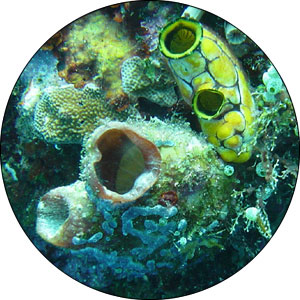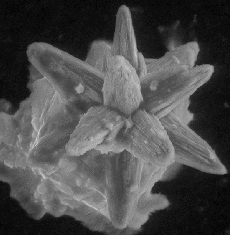|

Tunicates. Photo by Crissy Huffard, UCMP.
|
 |
The Urochordata, sometimes known as the Tunicata, are commonly
known as "sea squirts." The body of an adult tunicate is quite
simple, being essentially a sack with two siphons through which
water enters and exits. Water is filtered inside the sack-shaped
body. However, many tunicates
have a larva that is free-swimming and exhibits all
chordate
characteristics: it has a notochord, a dorsal nerve cord,
pharyngeal slits, and a post-anal tail. This "tadpole larva" will
swim for some time; in many tunicates, it eventually attaches to
a hard substrate, it loses its tail and ability to move, and its
nervous system largely disintegrates. Some tunicates are entirely
pelagic; known as salps, they typically have barrel-shaped bodies
and may be extremely abundant in the open ocean.
Urochordates have a sparse fossil record. A
Precambrian
fossil known as Yarnemia has been referred to the Urochordata, but this assignment
is doubtful. Complete body fossils of tunicates are rare, but tunicates in
some families generate microscopic spicules that may be
preserved as microfossils. Such spicules have occasionally
been described from Jurassic and later rocks. Few paleontologists are familiar with
them; tunicate spicules may be mistaken for sponge spicules.
Shown below is a spicule from a living tunicate from Moorea,
French Polynesia, photographed using an Environmental
Scanning Electron Microscope. Click on the image to view the full-sized
version.


 |

